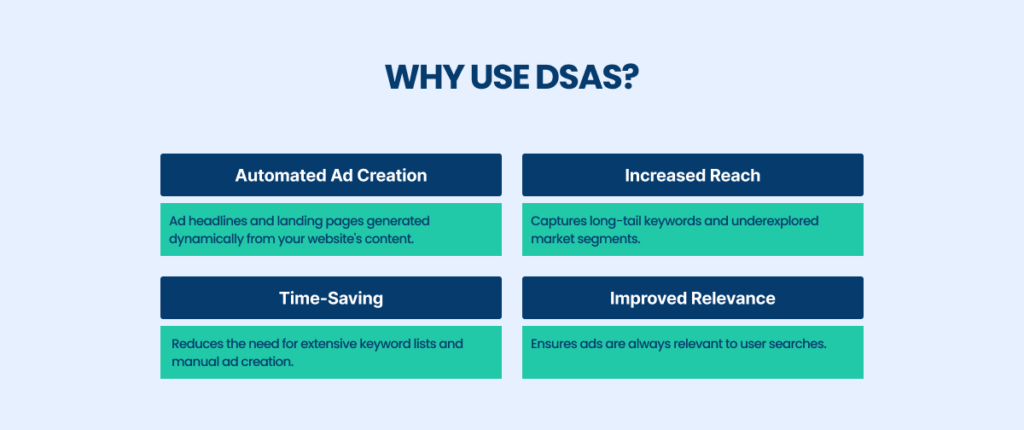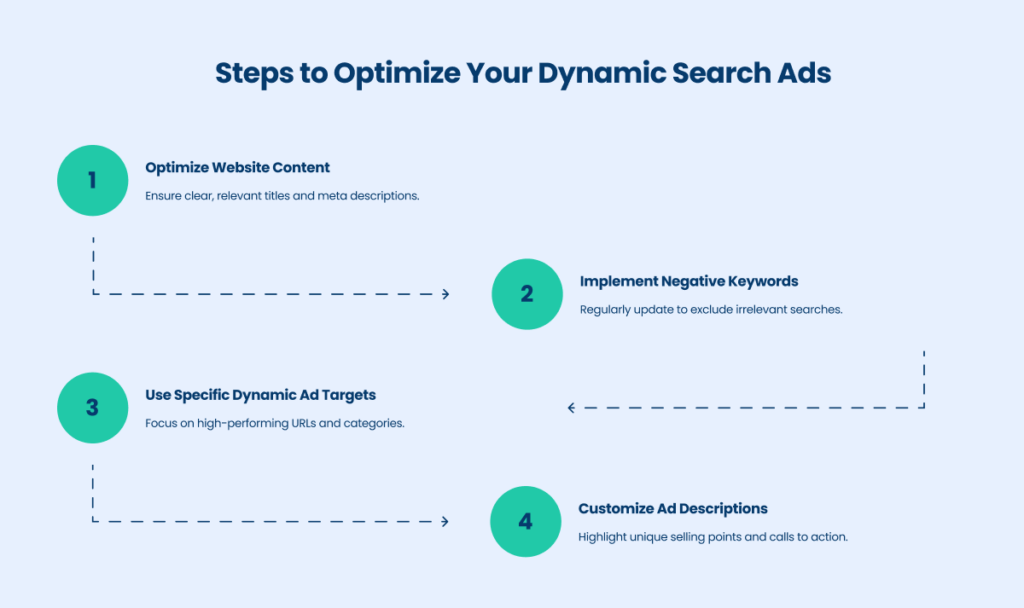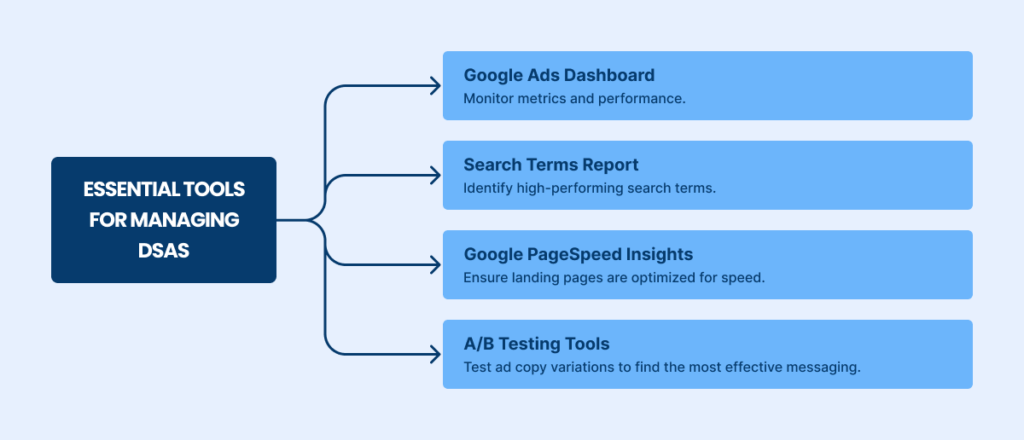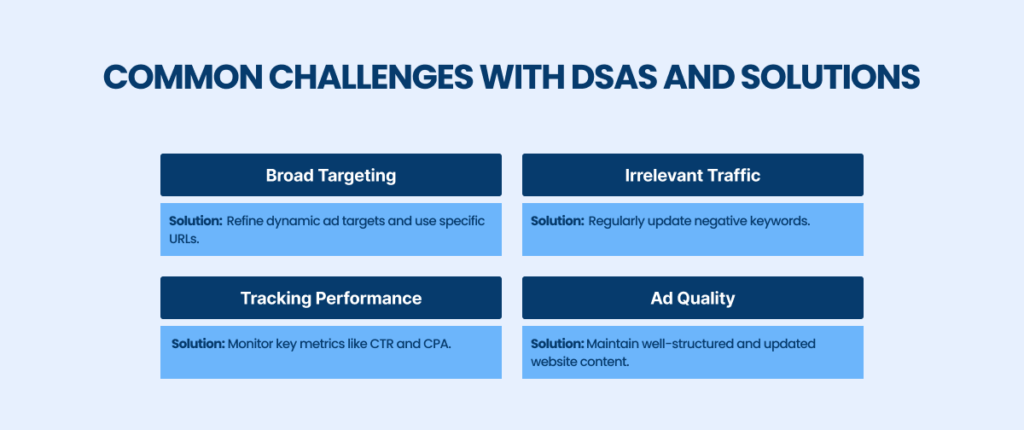The world of digital marketing is quite dynamic, and staying ahead means leveraging cutting-edge tools like Google Dynamic Search Ads (DSAs) to enhance your online presence and connect with the right audience.
Google Dynamic Search Ads are particularly effective because they dynamically generate ad headlines and landing pages based on your website’s content.
This user-friendly feature ensures that your ads are relevant to user searches without the need for extensive keyword lists, making it easy for you to manage your campaigns.
According to recent studies, businesses that upgrade DSA campaigns to Performance Max see an average increase of over 15% in conversions.
For companies looking to maximize the performance of their Google Ads campaigns, DSAs offer an efficient way to reach potential customers by targeting long-tail keywords and underexplored market segments.
This article will explore how to set up, optimize, and analyze dynamic search ads to get the most out of your advertising budget.
Whether you’re a seasoned advertiser or new to the field, understanding the nuances of DSAs can be a game-changer for your marketing strategy.
For businesses seeking professional assistance, partnering with a Google Ads Agency can provide the expertise to effectively leverage these powerful tools.
What Are Dynamic Search Ads?
One of the most significant advantages of dynamic search ads is that the results can be seen quickly.
In the first month, you can expect up to 10% improved sales performance, with this percentage increasing over time.
This highlights the impact DSAs can have on an overall digital marketing strategy.
Unlike traditional Google Ads that rely on specific keywords, DSAs automatically match ads to user searches based on your website’s content, allowing for broader and more dynamic targeting.
Google Dynamic Search Ads are particularly beneficial for businesses with extensive product lines or frequently updated content, such as those using Google Shopping Ads or engaging in Google Ads remarketing.
DSAs automatically generate ad headlines and landing pages, ensuring that the content shown is relevant to the searcher’s query.
This feature allows businesses to capture long-tail keywords and other search terms that might not be covered by traditional ad campaigns.
Setting up DSAs involves configuring your Google Ads account and selecting dynamic ad targets, such as specific pages or categories on your website.
This flexibility give you the opportunity to tailor your campaigns to different products or services, optimizing performance across various segments.
For example, an online retailer can use DSAs to automatically promote new or seasonal products, ensuring that ads are always up-to-date and relevant.
Overall, Dynamic Search Ads are a critical component of a comprehensive Google Ads strategy.
They work seamlessly with other ad formats like Google Display Ads and Google Shopping Ads, providing a cohesive and versatile approach to digital marketing and reassuring businesses of their compatibility.
For best results, businesses should engage in the continuous monitoring and refinement of their DSA campaigns.
This involves adjusting dynamic ad targets to align with market trends and business objectives, ensuring a dynamic and responsive approach.

Setting Up Dynamic Search Ads (DSAs)
Setting up Google Dynamic Search Ads (DSAs) can significantly enhance your online advertising strategy, especially for businesses with extensive inventories or frequently changing products.
Here’s a step-by-step guide to setting up DSAs, along with key considerations and tips:
Website Preparation
Ensure your website is well-structured and optimized for Google’s crawlers. This is crucial because DSAs automatically generate ad headlines and landing pages based on your site’s content.
Campaign Creation
Open a new campaign in your Google Ads account and select “Dynamic Search Ads.” Carefully select your dynamic ad targets.
These can include specific URLs, categories, or even the entire website. This flexibility allows you to focus on the most relevant sections of your site, ensuring that ads are highly targeted.
Organizing Ad Groups
Set up your ad groups within the DSA campaign based on specific product lines or categories. This organization helps you manage and analyze the performance of different segments.
Utilize negative keywords to get rid of irrelevant searches. This can significantly reduce wasted spend.
Ad Copy Customization
Although DSAs automatically generate headlines, you can customize the description lines. Use this space to highlight promotions, unique selling points, or calls to action (CTAs). For example, a description like “Discover our new arrivals! Shop now for exclusive deals” can drive engagement.
Integration with Other Formats
DSAs work well with other Google Ads formats, such as Google Display Ads and Google Shopping Ads. This integrated approach can increase brand visibility and capture a broader audience.
Google Ads remarketing can be an excellent addition, targeting users who have already interacted with your site. Remarketing ads can boost conversion rates by 26% on average.
Monitoring and Optimization:
Monitor your DSA campaigns regularly using Google Ads dashboard metrics like CTR, conversion rates, and cost-per-click (CPC).
Adjust dynamic ad targets, bids, and copy to match with evolving market trends and business objectives.
By following these steps and regularly optimizing your campaigns, you can boost the benefits of Google Dynamic Search Ads.
Consider exploring resources like Google’s official support page for more detailed guidance.
Best Practices for Dynamic Search Ads (DSAs)
To fully utilize the potential of DSAs, it’s crucial to implement best practices that enhance their effectiveness.
Here are some key strategies:
Optimize Website Content for DSAs
The core of successful Google Dynamic Search Ads lies in well-organized and descriptive website content. Ensure your site’s titles, meta descriptions, and on-page content are clear and relevant, as DSAs use this information to craft ads.
This optimization helps generate the most relevant ad copy and directs users to the most appropriate landing page, increasing the chances of conversion.
A well-structured site can significantly boost the performance of DSAs by up to 20%.
Implement Negative Keywords and Negative Dynamic Ad Targets
Utilizing negative keywords ensures your DSAs do not appear in irrelevant searches. This improves the relevance of your ads and optimizes your ad spend by focusing on high-intent queries.
Additionally, using hostile dynamic ad targets allows you to exclude specific pages from being used in DSAs, such as those not intended for commercial use.
Strategic Campaign Settings and Dynamic Ad Groups
Properly setting up your DSAs involves strategic planning of campaign settings and the organization of dynamic ad groups.
Segment your campaigns by specific product lines or services to target ads more precisely. This segmentation helps manage ad performance and make necessary adjustments based on data analytics.
Integrating your DSAs with other formats, such as Google Display Ads and Google Shopping Ads, can enhance your overall advertising reach and effectiveness. This integration ensures your advertising strategy covers various user touchpoints, increasing brand visibility.
Crafting Effective Ad Copy
While Google Dynamic Search Ads generate headlines automatically, you can customize the description lines. Use this space to highlight key features, special offers, or strong calls to action, such as “Explore Our New Collection” or “Limited Time Offer – Shop Now.”
Ensure the ad copy aligns closely with the user’s search intent and the most relevant landing page, enhancing ad relevance and performance.
Continuous Monitoring and Optimization:
Regularly monitoring your dynamic search ads campaigns is essential for sustained success. Use Google Ads dashboard metrics such as CTR, conversion rates, or return on ad spend (ROAS) to evaluate performance.
Based on these insights, refine dynamic ad targets, adjust bids, and update ad copy as needed. Continually update your negative keywords list to maintain the relevance of your ads.
Leverage Google Ads Remarketing
Integrating DSAs with Google Ads Remarketing can significantly enhance your campaigns by re-engaging users who have previously interacted with your website.
Remarketing can display dynamic ads tailored to the user’s previous interactions, thus increasing the likelihood of conversions.
By sticking to these best practices, businesses can optimize their Google Dynamic Search Ads campaigns, ensuring a more efficient use of ad spend and a higher return on investment.
For tailored strategies and professional campaign management, consider consulting with Azarian Growth Agency.
We offer comprehensive services to maximize your DSAs’ effectiveness!

Tracking and Analyzing DSA Performance
Tracking and analyzing the performance of your Google Dynamic Search Ads (DSA) is going not just a task; it’s a pathway to growth and improvement.
This process involves monitoring several key metrics that indicate the effectiveness and efficiency of your ads, providing you with the insights you need to make your campaigns more successful.
1. Click-Through Rate (CTR)
The Click-Through Rate (CTR) is a critical metric that checks how often users click on your Google Dynamic Search Ads compared to how usually they are shown. A higher CTR means that your ads are relevant and compelling to the audience.
Studies have shown that optimizing your ad copy and targeting the right audience can significantly improve CTR.
2. Conversion Rate
Conversion rate is a metric that indicates the percentage of users who take a preferred action, such as making a purchase, after clicking on your ads.
For Google Dynamic Search Ads, a high conversion rate suggests that the ads attract clicks and effectively lead to conversions. Enhancing landing page relevance and ensuring a seamless user experience is critical to improving this metric.
3. Cost per Conversion
Cost per Conversion or Cost Per Acquisition (CPA), measures the conversion cost. Tracking CPA helps assess the efficiency of your ad spend in Google Dynamic Search Ads campaigns.
Lowering CPA often involves refining ad targeting, improving ad copy, and optimizing landing pages to meet user needs better.
Regularly analyzing performance metrics such as CTR, conversion rates, and CPA helps identify opportunities for refining dynamic ad targets and ad copy.
This ensures that your Google Dynamic Search Ads are consistently aligned with user intent and effectively drive conversions.
4. Search Terms Report
This is an essential tool for analyzing the specific queries that trigger your Google Dynamic Search Ads. By examining this report, you can identify high-performing search terms and add negative keywords to eliminate irrelevant searches.
This process helps optimize ad spending and ensure your ads reach the most relevant audience.
5. Dynamic Ad Targets and Ad Copy Testing
Regularly updating and refining your dynamic ad targets is crucial for maintaining the relevance of your ads. Testing different ad copy variations can also help identify which messages work best with your audience.
A/B testing of headlines and descriptions can significantly improve engagement and conversion rates, showing your audience that their preferences and needs are at the heart of your campaign strategy.
6. Quality Score
This is a criterion used by Google to determine the relevance and quality of your Google Dynamic Search Ads, keywords, and landing pages. A higher Quality Score may cause lower costs and better ad placements.
To improve the Quality Score, focus on aligning your ads with the user’s search intent, optimizing ad copy, and enhancing the user experience on your landing pages.
By closely monitoring these metrics and continuously optimizing your Google Dynamic Search Ads campaigns, you can achieve better results and more efficient use of your advertising budget.
Remember, the journey to success is within progress, and your commitment to optimization will keep your campaigns at the top of their game.

Addressing Common Challenges in Dynamic Search Ads (DSAs)
One significant issue is broad targeting, which can attract irrelevant traffic. This problem often occurs when DSAs target all the URLs on your site or broad categories, leading to ads appearing for searches that are not connected to your products or services.
To overcome this, it’s crucial to refine your targeting. You can select specific page feeds or target URLs to narrow down the content Google’s index uses to generate ads.
This approach ensures that the ads align more with relevant search queries, increasing the likelihood of conversions.
Managing negative keywords is another critical challenge. DSAs can sometimes match ads to unrelated search terms, wasting ad spend on clicks that don’t convert.
To address this, it’s essential to regularly update your list of negative keywords based on the search terms report.
This practice helps exclude terms that are not relevant to your business, optimize your campaign type, and ensure that the right audience sees your ads.
Ensuring the relevance and quality of ads generated by DSAs can also be challenging. Since DSAs use your website content to create ad headlines and descriptions, the quality of your ads depends heavily on how well your website is optimized.
It is vital to maintain a well-developed website with straightforward, concise content. This includes ensuring your display URLs are accurate and your content is aligned with the potential search queries your audience might use.
Regular site updates can improve the ads’ quality and relevance, thus enhancing your overall campaign performance.
Finally, tracking and measuring DSAs’ performance can be tricky due to their automated nature. Regular monitoring of key metrics such as conversion rate, click-through rate (CTR), and conversion value is essential.
These metrics provide insights into your DSAs’ performance and where improvements can be made.
Adjusting your bidding strategy based on these metrics can help optimize your campaigns, ensuring better alignment with business goals and more efficient use of your ad budget.
By addressing these common challenges, you can maximize your Google Dynamic Search Ads, ensuring that your campaigns are effective and aligned with your marketing objectives.

Master Google Ads with Azarian Growth Agency!
Are you ready to better your digital marketing strategy with Dynamic Search Ads (DSAs)?
Whether you’re seeking to streamline ad management, increase ROI, or achieve exceptional campaign results, A Professional Google Ads Agency provides a powerful solution.
At Azarian Growth Agency, we specialize in Google Ads services designed to elevate your brand and deliver measurable success.
Our experienced team offers the insights and strategies to ensure your campaigns are effective and exceptional. In the competitive landscape of digital marketing, differentiation is crucial.
With our expertise in DSAs, you’re not just distinguishing your brand; you’re setting the standard.
Let’s collaborate to realize your marketing ambitions. Ready to begin?
Get Your Free Marketing Plan today and experience our impact on your business.

